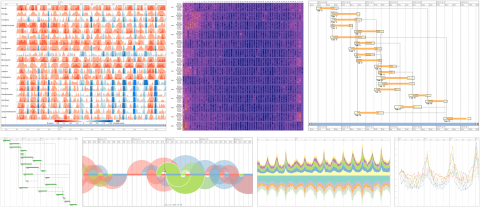TimeBench: A Data Model and Software Library for Visual Analytics of Time-Oriented Data
 Time-oriented data play an essential role in many Visual Analytics scenarios such as extracting medical insights from collections of electronic health records or identifying emerging problems and vulnerabilities in network traffic. However, many software libraries for Visual Analytics treat time as a flat numerical data type and insufficiently tackle the complexity of the time domain such as calendar granularities and intervals. Therefore, developers of advanced Visual Analytics designs need to implement temporal foundations in their application code over and over again.
Time-oriented data play an essential role in many Visual Analytics scenarios such as extracting medical insights from collections of electronic health records or identifying emerging problems and vulnerabilities in network traffic. However, many software libraries for Visual Analytics treat time as a flat numerical data type and insufficiently tackle the complexity of the time domain such as calendar granularities and intervals. Therefore, developers of advanced Visual Analytics designs need to implement temporal foundations in their application code over and over again.
This work was supported by the Austrian Federal Ministry of Economy, Family and Youth via CVAST, a Laura Bassi Centre of Excellence (#822746), and by the Austrian Science Fund (FWF) via the HypoVis project (#P22883).
TimeBench is a free and open source software library that provides foundational data structures and algorithms for time-oriented data in Visual Analytics. Its expressiveness and developer accessibility have been evaluated through application examples demonstrating a variety of challenges with time-oriented data and long-term developer studies conducted in the scope of research and student projects.

Application examples built using TimeBench: (1) Monthly health data of 20 cities over 14 years in a Horizon Graph; (2) 14 years of daily health data in a GROOVE visualization; (3) a project plan using the PlanningLines metaphor; (4) a project plan as a Gantt chart; (5) an Arc Diagram showing relationships between events of three categories; (6) a ThemeRiver visualization; (7) multiple line plots with indexing. Health data from the NMMAPS study is used in (1), (2), (5), (6), and (7).
| Source Code | Demos | Paper |
Publications

|
Alexander Rind, Tim Lammarsch, Wolfgang Aigner, Bilal Alsallakh, Silvia Miksch, "TimeBench: A Data Model and Software Library for Visual Analytics of Time-Oriented Data", IEEE Transactions on Visualization and Computer Graphics, Special Issue "VIS 2013", vol. 19, pp. 2247-2256, 2013. Project page Introduction and Basic Features |

